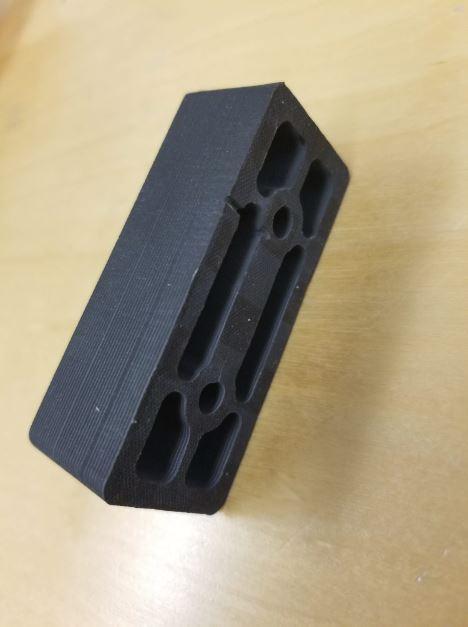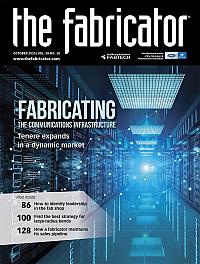Editor-in-Chief
- FMA
- The Fabricator
- FABTECH
- Canadian Metalworking
Categories
- Additive Manufacturing
- Aluminum Welding
- Arc Welding
- Assembly and Joining
- Automation and Robotics
- Bending and Forming
- Consumables
- Cutting and Weld Prep
- Electric Vehicles
- En Español
- Finishing
- Hydroforming
- Laser Cutting
- Laser Welding
- Machining
- Manufacturing Software
- Materials Handling
- Metals/Materials
- Oxyfuel Cutting
- Plasma Cutting
- Power Tools
- Punching and Other Holemaking
- Roll Forming
- Safety
- Sawing
- Shearing
- Shop Management
- Testing and Measuring
- Tube and Pipe Fabrication
- Tube and Pipe Production
- Waterjet Cutting
Industry Directory
Webcasts
Podcasts
FAB 40
Advertise
Subscribe
Account Login
Search
Bringing real-world metal fabricating to college
Oregon State’s manufacturing lab gets a taste of true 2D cutting power with a small waterjet
- By Dan Davis
- October 24, 2020
- Article
- Waterjet Cutting

Oregon State’s Mechanical, Industrial, and Manufacturing Engineering (MIME) Lab obtained a ProtoMAX abrasive waterjet cutting machine from OMAX in 2019, and it’s proven to be the right fit for the lab. According to Brian Jensen, the lab manager, the machine has a small footprint but can deliver the cutting power of a typical waterjet. It’s also not too intimidating for students who have not been around machine tools a lot because the cutting envelope is totally contained and the machine is quiet when operating. Images provided
Manufacturing in the U.S. finds itself at an interesting intersection. Gone are the days when a wall existed between engineering and the shop floor. The engineers no longer throw the design over that wall and expect the shop floor to figure it out. Today’s mechanical engineers are likely to spend as much time on the shop floor trying to prove out technology or investigate design for manufacturability issues. Simultaneously, it should be noted that today’s engineers probably come to their jobs with different backgrounds. Their hands-on experiences are not going to be as rich as the engineers' who grew up working on their cars back in the day.
Brian Jensen, the manager of the Mechanical, Industrial, and Manufacturing Engineering (MIME) Laboratory at Oregon State University, Corvallis, Ore., is here to tell you that you shouldn’t worry. Today’s engineering students are bright and very good conceptual thinkers. Jensen said that where they might fall short is in the hands-on experiences of actually building things and rebuilding them when they don’t quite work. But engineering labs like Oregon State’s are designed to help introduce them to the real-world technologies that make the computer work a reality. That’s been a little easier for Jensen since the lab acquired a waterjet cutting machine that proved to be the perfect fit, literally and figuratively.
Getting a Cutting-edge Experience
Jensen holds bachelor’s and master’s degrees in mechanical engineering from Oregon State. After graduating in 1999, he spent five years in the manufacturing industry. After earning his advanced degree in 2006, he went to work for Idaho National Laboratory in the radioisotope power systems department, developing fuel systems that help propel space probes across the solar system. He returned to his alma mater to run the MIME Lab in 2011. He said his real-world background both in manufacturing and high-tech research and development provide him with well-rounded advice when it comes to counseling engineering students who really have no idea what awaits them when they look to get a job after graduation.
“The level of experience of the students is pretty varied. The bulk of the students that we get are young, straight out of high school,” he said. “They really start getting their fingers into stuff in their third year of engineering school here. At that time they’ve done a lot of math, physics, and theoretical coursework. They’re hungry to get into actually making things, but the bulk of them don’t have a lot of experience doing that. Some of them still grow up on farms, and some still tinker with things. But a lot of them just don’t have much hands-on experience, particularly the foreign students.”
That’s why labs are important to the overall education for these engineering students, Jensen added, as it gives them an introduction as to how things are made. The MIME Lab is a good reflection of what they might see in a shop as it contains four CNC vertical milling machines, two CNC lathes, an electrical discharge machining unit, gas metal arc and gas tungsten arc welding machines, 3D printers, and a variety of woodworking equipment. On the sheet metal side, however, the equipment was limited to a shear, a box and pan brake, and a vertical band saw. If students wanted something cut with a higher degree of tolerance, they tried to figure out how to do it on one of the milling centers, which wasn’t an ideal situation.
All of this equipment is spread over several rooms. Jensen said the lab has slowly grown since the days when he walked the halls as a student. Even with the extra room, the lab is pretty tight, and the student population has grown to about 1,000 undergrads and 500 graduate students, most looking for some time in front of the manufacturing equipment in the lab. Space is at a premium.
Despite the cramped quarters, Jensen said he was looking to introduce new technologies to the lab. “If nothing else, students can walk by a machine, see it, and know that it exists.”
He didn’t have a plasma cutting table, as it would be too large and require ventilation work to be done once installed. The lab did have a small laser cutting machine at one time, but it never really worked properly; anything new would be too large and expensive. He said he had his eye on waterjet cutting for years, but couldn’t justify it because even the smallest machines were too large and incompatible with the realities of working in a small lab. The smallest tables had a 4- by 4-ft. footprint, but when the pump and controls were added to the machine setup, the actual footprint was more like 6 by 8 ft.
Then he came across the ProtoMAX waterjet cutting machine from OMAX. The unit, which has a footprint of 41.5 by 39.5 in., a height of 56.5 in., and sits on four casters, was perfect for the lab.
“I saw that little guy and knew we could wheel it right into the lab. It has a cover. It runs like a waterjet. So I called up OMAX right away,” he said.

The MIME Lab actually has cut more nonmetal materials, such as carbon fiber, than metal parts since acquiring the waterjet.
Oregon State’s MIME Lab was about to get modern, CNC 2D cutting capabilities in just the right-sized package.
Putting the Unit to Work
The machine arrived in August 2019, and students were champing at the bit to use it. Jensen realized that some sort of introductory session was needed because, even if it came in a small package, it was still a fully functioning waterjet.
“I wasn’t going to give the keys to a Ferrari to a 16-year-old on his birthday,” he said.
The waterjet has a cutting envelope of 1 by 1 ft. with a cover that sits over it. (The cover helps to keep cutting operations quiet, around 76 dB.) It has a top cutting speed of 100 IPM and repeatability of +/- 0.0030 in. It can generate up to 30,000 PSI of cutting power with its 5-HP pump. OMAX specifications for the machine suggest that it can cut “virtually” any material under 1 in. thick. The waterjet plugs into a 240-VAC, single-phase outlet.
After the waterjet was installed in the MIME Lab, one of the first groups to use it was the university’s Society for Automotive Engineers club, which builds a carbon-fiber vehicle every year that they then race against other universities’ vehicles. They wanted to use the waterjet to cut out cylindrical carbon-fiber hard points, which would be used as sleeving for pins or bolts. These hard points can absorb the loads that emanate from the pins or bolts and help to transfer the stress to the carbon-fiber skin of the vehicle frame.
The university’s rocketry club was another group that gravitated to the new waterjet. Club members craft rockets that range in size from 6 to 30 ft. tall and 8 to 10 in. in diameter. One of the more challenging aspects of the rocket fabrication is the creation of wings for the tail end of the rocket. In the past the students used the 3-axis milling machines to cut the wings out of plastic and fiberglass materials. Jensen said that can get a bit complicated for a person who has only worked with blocks of aluminum inside the mill. Trying to figure out how the material should go in there and be fixtured while programming the machine to cut these very intricate shapes was difficult and time-consuming.
“With the waterjet, they just slap the thing in there and just cut it. That’s allowed them to make that whole process a lot easier,” Jensen said. “As a result, they have added a lot more little windows and pockets for lightening things up and for the mounting of control arms.” A day’s effort is now reduced to a few hours’ work.
The students designing these parts are using the same IntelliMAX software that runs OMAX’s larger waterjets. When a university purchases the ProtoMAX, it gets unlimited software seats for the IntelliMAX Proto software.
Jensen said that ability to work with the designs in 3D modeling software, import the model into the layout program, manipulate it inside the same program, and then create the cutting program to operate the waterjet’s cutting head is a great experience for students. They are actually replicating the activities that any small-shop owner or employee might be involved in themselves.
“They go through the whole experience and then kick on the machine,” Jensen said. “They realize that they can dream something up and have a prototype in the hand in an hour.”
That’s what industry wants to hear. They need employees to hit the ground running. There are parts to be made, not theory to be discussed.
About the Author

Dan Davis
2135 Point Blvd.
Elgin, IL 60123
815-227-8281
Dan Davis is editor-in-chief of The Fabricator, the industry's most widely circulated metal fabricating magazine, and its sister publications, The Tube & Pipe Journal and The Welder. He has been with the publications since April 2002.
Related Companies
subscribe now

The Fabricator is North America's leading magazine for the metal forming and fabricating industry. The magazine delivers the news, technical articles, and case histories that enable fabricators to do their jobs more efficiently. The Fabricator has served the industry since 1970.
start your free subscription- Stay connected from anywhere

Easily access valuable industry resources now with full access to the digital edition of The Fabricator.

Easily access valuable industry resources now with full access to the digital edition of The Welder.

Easily access valuable industry resources now with full access to the digital edition of The Tube and Pipe Journal.
- Podcasting
- Podcast:
- The Fabricator Podcast
- Published:
- 04/16/2024
- Running Time:
- 63:29
In this episode of The Fabricator Podcast, Caleb Chamberlain, co-founder and CEO of OSH Cut, discusses his company’s...
- Industry Events
16th Annual Safety Conference
- April 30 - May 1, 2024
- Elgin,
Pipe and Tube Conference
- May 21 - 22, 2024
- Omaha, NE
World-Class Roll Forming Workshop
- June 5 - 6, 2024
- Louisville, KY
Advanced Laser Application Workshop
- June 25 - 27, 2024
- Novi, MI
































